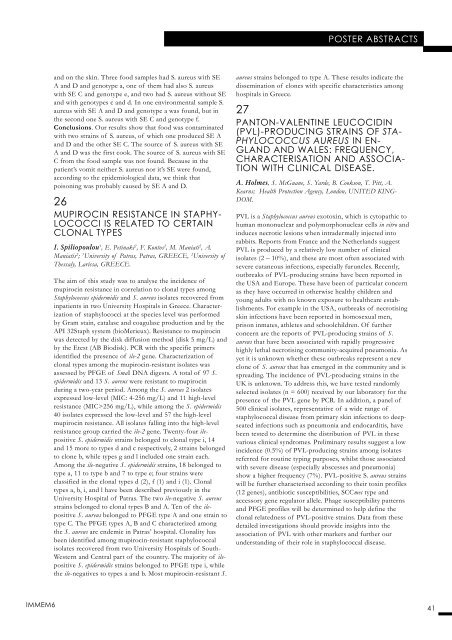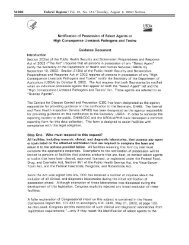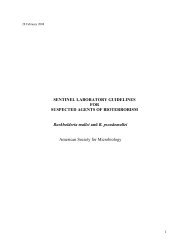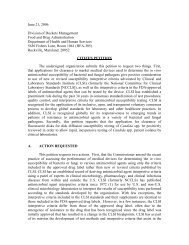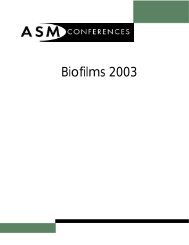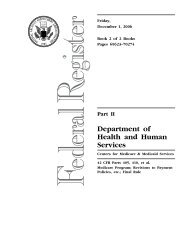Program and Abstract Book - Microbiology
Program and Abstract Book - Microbiology
Program and Abstract Book - Microbiology
Create successful ePaper yourself
Turn your PDF publications into a flip-book with our unique Google optimized e-Paper software.
POSTER SESSION APOSTER ABSTRACTS<strong>and</strong> on the skin. Three food samples had S. aureus with SEA <strong>and</strong> D <strong>and</strong> genotype a, one of them had also S. aureuswith SE C <strong>and</strong> genotype e, <strong>and</strong> two had S. aureus without SE<strong>and</strong> with genotypes c <strong>and</strong> d. In one environmental sample S.aureus with SE A <strong>and</strong> D <strong>and</strong> genotype a was found, but inthe second one S. aureus with SE C <strong>and</strong> genotype f.Conclusions. Our results show that food was contaminatedwith two strains of S. aureus, of which one produced SE A<strong>and</strong> D <strong>and</strong> the other SE C. The source of S. aureus with SEA <strong>and</strong> D was the first cook. The source of S. aureus with SEC from the food sample was not found. Because in thepatient’s vomit neither S. aureus nor it’s SE were found,according to the epidemiological data, we think thatpoisoning was probably caused by SE A <strong>and</strong> D.26MUPIROCIN RESISTANCE IN STAPHY-LOCOCCI IS RELATED TO CERTAINCLONAL TYPESI. Spiliopoulou 1 , E. Petinaki 2 , F. Kontos 2 , M. Maniati 2 , A.Maniatis 2 ; 1 University of Patras, Patras, GREECE, 2 University ofThessaly, Larissa, GREECE.The aim of this study was to analyse the incidence ofmupirocin resistance in correlation to clonal types amongStaphylococcus epidermidis <strong>and</strong> S. aureus isolates recovered frominpatients in two University Hospitals in Greece. Characterizationof staphylococci at the species level was performedby Gram stain, catalase <strong>and</strong> coagulase production <strong>and</strong> by theAPI 32Staph system (bioMerieux). Resistance to mupirocinwas detected by the disk diffusion method (disk 5 mg/L) <strong>and</strong>by the Etest (AB Biodisk). PCR with the specific primersidentified the presence of ile-2 gene. Characterization ofclonal types among the mupirocin-resistant isolates wasassessed by PFGE of SmaI DNA digests. A total of 97 S.epidermidis <strong>and</strong> 13 S. aureus were resistant to mupirocinduring a two-year period. Among the S. aureus 2 isolatesexpressed low-level (MIC: 4-256 mg/L) <strong>and</strong> 11 high-levelresistance (MIC>256 mg/L), while among the S. epidermidis40 isolates expressed the low-level <strong>and</strong> 57 the high-levelmupirocin resistance. All isolates falling into the high-levelresistance group carried the ile-2 gene. Twenty-four ilepositiveS. epidermidis strains belonged to clonal type i, 14<strong>and</strong> 15 more to types d <strong>and</strong> c respectively, 2 strains belongedto clone b, while types g <strong>and</strong> l included one strain each.Among the ile-negative S. epidermidis strains, 18 belonged totype a, 11 to type b <strong>and</strong> 7 to type e; four strains wereclassified in the clonal types d (2), f (1) <strong>and</strong> i (1). Clonaltypes a, b, i, <strong>and</strong> l have been described previously in theUniversity Hospital of Patras. The two ile-negative S. aureusstrains belonged to clonal types B <strong>and</strong> A. Ten of the ilepositiveS. aureus belonged to PFGE type A <strong>and</strong> one strain totype C. The PFGE types A, B <strong>and</strong> C characterized amongthe S. aureus are endemic in Patras’ hospital. Clonality hasbeen identified among mupirocin-resistant staphylococcalisolates recovered from two University Hospitals of South-Western <strong>and</strong> Central part of the country. The majority of ilepositiveS. epidermidis strains belonged to PFGE type i, whilethe ile-negatives to types a <strong>and</strong> b. Most mupirocin-resistant S.aureus strains belonged to type A. These results indicate thedissemination of clones with specific characteristics amonghospitals in Greece.27PANTON-VALENTINE LEUCOCIDIN(PVL)-PRODUCING STRAINS OF STA-PHYLOCOCCUS AUREUS IN EN-GLAND AND WALES: FREQUENCY,CHARACTERISATION AND ASSOCIA-TION WITH CLINICAL DISEASE.A. Holmes, S. McGuane, S. Yarde, B. Cookson, T. Pitt, A.Kearns; Health Protection Agency, London, UNITED KING-DOM.PVL is a Staphylococcus aureus exotoxin, which is cytopathic tohuman mononuclear <strong>and</strong> polymorphonuclear cells in vitro <strong>and</strong>induces necrotic lesions when intradermally injected intorabbits. Reports from France <strong>and</strong> the Netherl<strong>and</strong>s suggestPVL is produced by a relatively low number of clinicalisolates (2 – 10%), <strong>and</strong> these are most often associated withsevere cutaneous infections, especially furuncles. Recently,outbreaks of PVL-producing strains have been reported inthe USA <strong>and</strong> Europe. These have been of particular concernas they have occurred in otherwise healthy children <strong>and</strong>young adults with no known exposure to healthcare establishments.For example in the USA, outbreaks of necrotisingskin infections have been reported in homosexual men,prison inmates, athletes <strong>and</strong> schoolchildren. Of furtherconcern are the reports of PVL-producing strains of S.aureus that have been associated with rapidly progressivehighly lethal necrotising community-acquired pneumonia. Asyet it is unknown whether these outbreaks represent a newclone of S. aureus that has emerged in the community <strong>and</strong> isspreading. The incidence of PVL-producing strains in theUK is unknown. To address this, we have tested r<strong>and</strong>omlyselected isolates (n = 600) received by our laboratory for thepresence of the PVL gene by PCR. In addition, a panel of500 clinical isolates, representative of a wide range ofstaphylococcal disease from primary skin infections to deepseatedinfections such as pneumonia <strong>and</strong> endocarditis, havebeen tested to determine the distribution of PVL in thesevarious clinical syndromes. Preliminary results suggest a lowincidence (0.5%) of PVL-producing strains among isolatesreferred for routine typing purposes, whilst those associatedwith severe disease (especially abscesses <strong>and</strong> pneumonia)show a higher frequency (7%). PVL-positive S. aureus strainswill be further characterised according to their toxin profiles(12 genes), antibiotic susceptibilities, SCCmec type <strong>and</strong>accessory gene regulator allele. Phage susceptibility patterns<strong>and</strong> PFGE profiles will be determined to help define theclonal relatedness of PVL-positive strains. Data from thesedetailed investigations should provide insights into theassociation of PVL with other markers <strong>and</strong> further ourunderst<strong>and</strong>ing of their role in staphylococcal disease.IMMEM641


